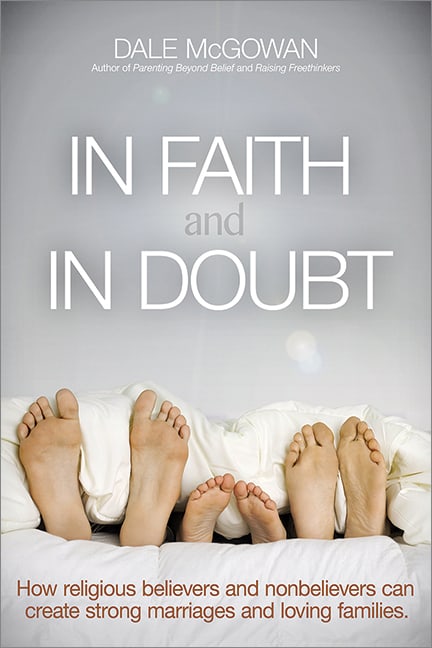When I started the research for In Faith and In Doubt, a book about marriages between religious believers and nonbelievers, I crowd-sourced a few early questions on Facebook. At one point I was looking for a good label for such marriages. “Interfaith” doesn’t quite cut it, since only one partner is in a faith tradition. So what would you call a marriage between a believer and a nonbeliever?
“Short,” was one reply.
That’s cute. But in many cases, including my own marriage (an atheist who married a Southern Baptist), it’s also simply not true. Still, again and again I hear people, articles, and books saying it just can’t work.
I’ve been an atheist since my early teens, and for years I was convinced there were only two atheists in the world: me, and Madalyn Murray O’Hair—the loud, aggressive, profane founder of American Atheists. Madalyn had contempt for all things religious, and she let everyone know it. When I was growing up, she was the only atheist anyone knew—except for the millions of us who silently counted ourselves as The Only Other Atheist in the World Besides the Scary Lady on TV.
When most people think of an atheist married to a Christian, they picture Madalyn Murray O’Hair snuggling up to televangelist Pat Robertson. No surprise that they can’t imagine the marriage even getting as far as the reception.
But the great news for the secular/religious marriage is that “Pat ‘n’ Madalyn” is a cartoon with very little to say about the people actually living these marriages. That’s because most nonbelievers are nothing like Madalyn, and most believers are nothing like Pat.
Despite the culture war bullets whizzing over their heads, there’s more common ground and common experience than ever before between the average religious believer and the average nonbeliever.
If you look only at the doctrines of many religious denominations, it’s hard to find much common ground with nonbelievers. But look at the actual people in those denominations and the picture brightens considerably.
Let’s take three examples. Most secular Americans strongly support gay rights, women’s reproductive rights, and access to birth control, but the Catholic Catechism declares homosexuality a “grave depravity,” abortion a “moral evil,” and birth control “intrinsically evil.” So you might think an atheist and a Catholic could never find common ground on these deeply-felt social issues.
And you’d be wrong. Despite the doctrines, 54% of Catholics support gay marriage, 58% support abortion rights, and an amazing 82% believe birth control is morally acceptable. So U.S. Catholics have more common ground with the nonreligious than with the, uh…Catholic Church.
It’s not just Catholics. Mainline Protestants also support gay marriage (55%), abortion rights (72%), and access to birth control (85%) in numbers much higher than many assume. Two-thirds of U.S. Christians accept evolution, and fewer than a third are biblical literalists—down from two-thirds in 1963.
Most telling of all, 46% of Mainline Protestants and 49% of Catholics now say even an atheist can go to heaven. Not to mention 100% of current popes.
On the atheist side, a recent University of Tennessee study showed that fewer than 15% of atheists are actually “anti-theists,” those who consider all religion to be toxic and harmful. That’s only one in seven. The rest, to varying degrees, are perfectly willing to co-exist with people of different beliefs.
When you get beyond the cartoons of belief and disbelief, it’s less unthinkable that religious and nonreligious people are making strong, happy marriages together. They aren’t Pat and Madalyn—they are couples so similar in values and attitudes, even as they differ in beliefs, that they’re probably all around you and you can’t even tell.
And that’s a good thing.
DALE McGOWAN, Ph.D., a Harvard Humanist of the Year, teaches workshops on secular parenting and serves as Executive Director of the charitable Foundation Beyond Belief. He is the author of In Faith, and In Doubt: How Religious Believers and Non Believers Can Create Strong Marriages and Loving Families.
By Dale McGowan


